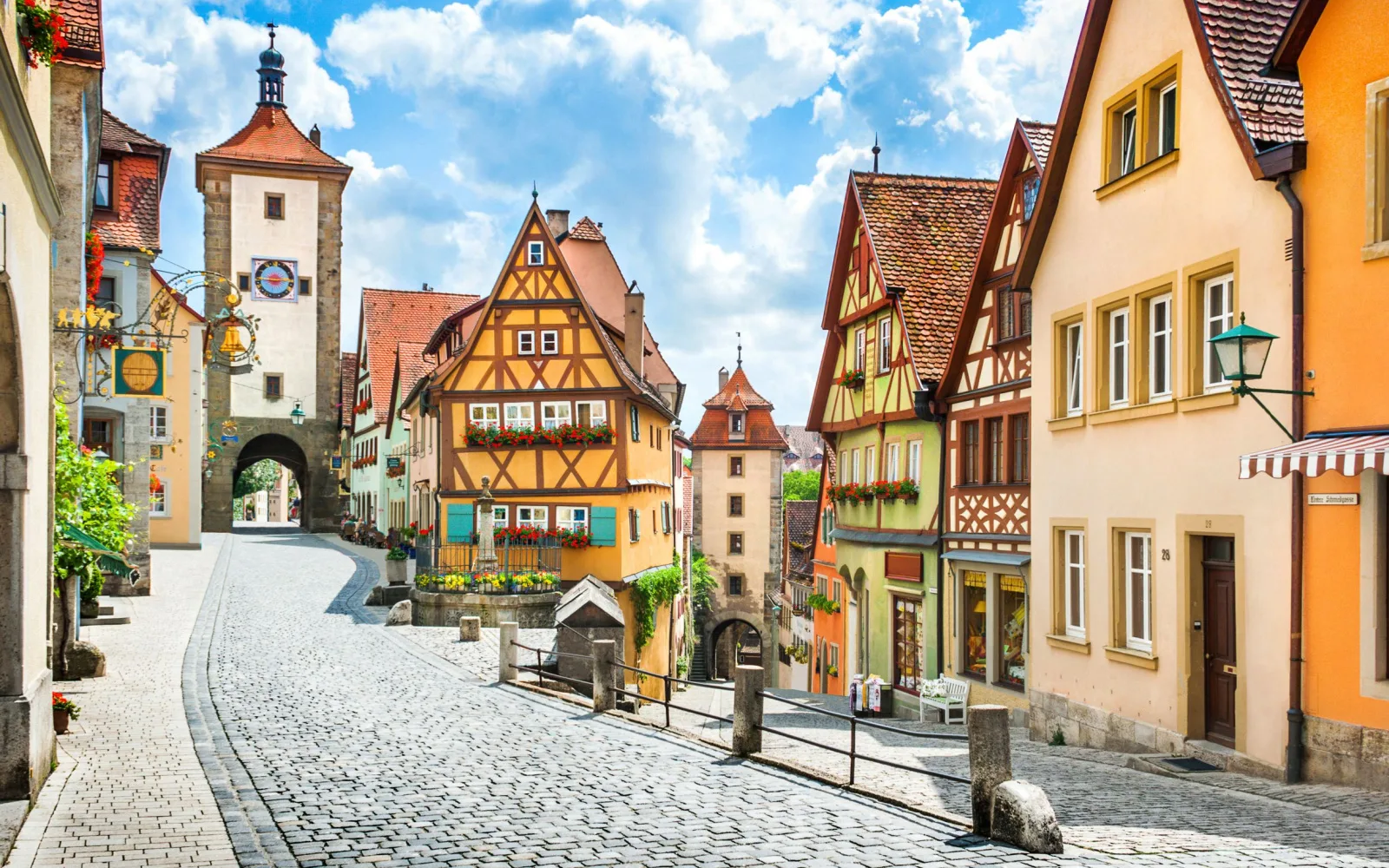Learn the best places to visit in Germany if you’re up for some incredible architecture, vibrant cities, delicious food and drinks, and amazing scenery with views of castles, snow-capped mountains, fairytale forests, and crystal-clear lakes and rivers.
This historic country is packed with interesting places to visit and things to do, no matter which region you’re heading to. From the modern edge and historic cathedrals of Berlin to storybook castles built on rugged mountain peaks, Germany is one of our favorite places to travel when you want to see, do, and experience.
Let’s take a look at the 15 best places to visit in Germany and start filling up your itinerary with the country’s best sights, destinations, and attractions!
15 of the Best Places to Visit in Germany
Think of Germany, and it’s likely that a few things come to mind: Oktoberfest, sausages, and biergartens, WWII history, bustling cities like Berlin and Munich, the Black Forest, medieval castles, and charming Bavarian villages with mountain and lake views.
Some countries don’t live up to the hype — once you get there, you see that their destinations and attractions have been a bit exaggerated — but Germany’s not like that. This is truly a fascinating, diverse country with great places to visit.
You’ll find yourself wanting to check off every place on this list and spend as much time in Germany as possible. There’s just so much to see and do!
We’ve narrowed it down to the 15 best places to visit in Germany below. Take a look and see which destinations you don’t want to miss on your upcoming trip.
1. Berlin
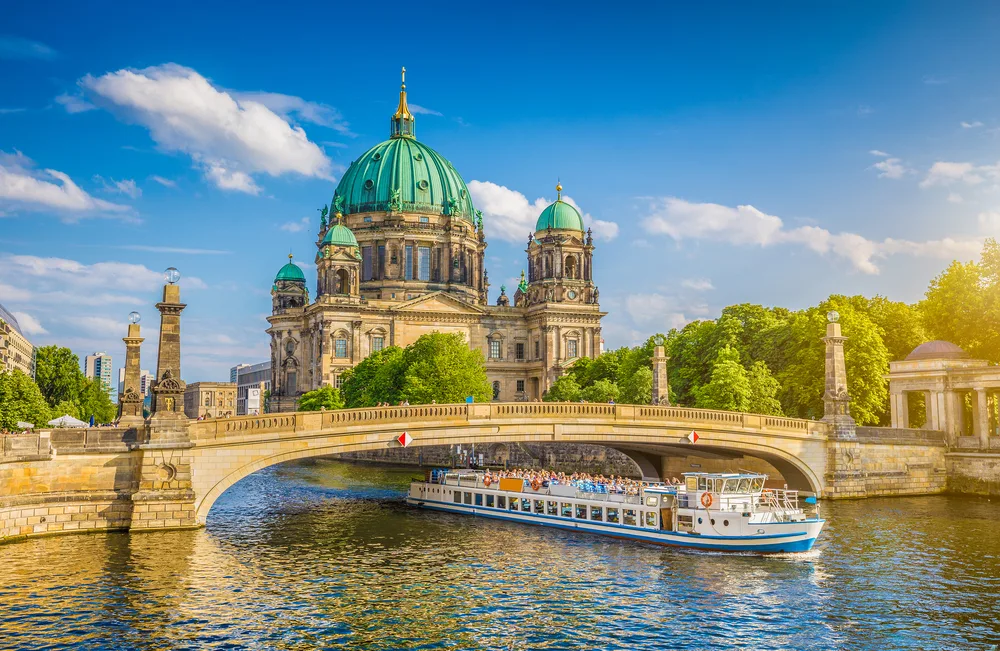
Canadastock/Shutterstock
Walkable with great public transit, amazingly green, and equal parts modern and historic with a little artistic and musical edge, Berlin is a counter-culture city that hasn’t forgotten its past. The music, art, and vibrant neighborhoods are just as iconic as the museums and historic landmarks here.
The first thing you’ll notice is that Berlin doesn’t feel crowded or rushed like other metropolises. It’s a city to enjoy at your leisure — lush with tons of green spaces and lakes, wide sidewalks and bike lanes, and there’s always a concert, art show, or festival going on.
You’ll want to check out Berlin’s most popular museums, like Topography of Terror (20th century history), the famed Museum Island with 5 museums in the heart of the city, and the German Historical Museum just 2 minutes away.
But the real Berlin lives outside of your typical sightseeing route. It’s in the graffiti’d spätis, or late-night bodega-style shops that sell €1 wegbiers (beers taken to-go), the music venues blasting techno to black metal, and the amazing array of places to grab food and drinks or dance into the wee hours of the morning.
A typical day might be breakfast with German pancakes and coffee, a little walking tour sightseeing (the domed Berlin Cathedral and Brandenburg Gate are a must), lunch with international flair (Asian, Middle Eastern, and Italian options abound), and checking out a show, market, or festival before grabbing a hearty German dinner and a few beers.
Read Next: The Best & Worst Times to Visit Berlin in 2025
2. Munich
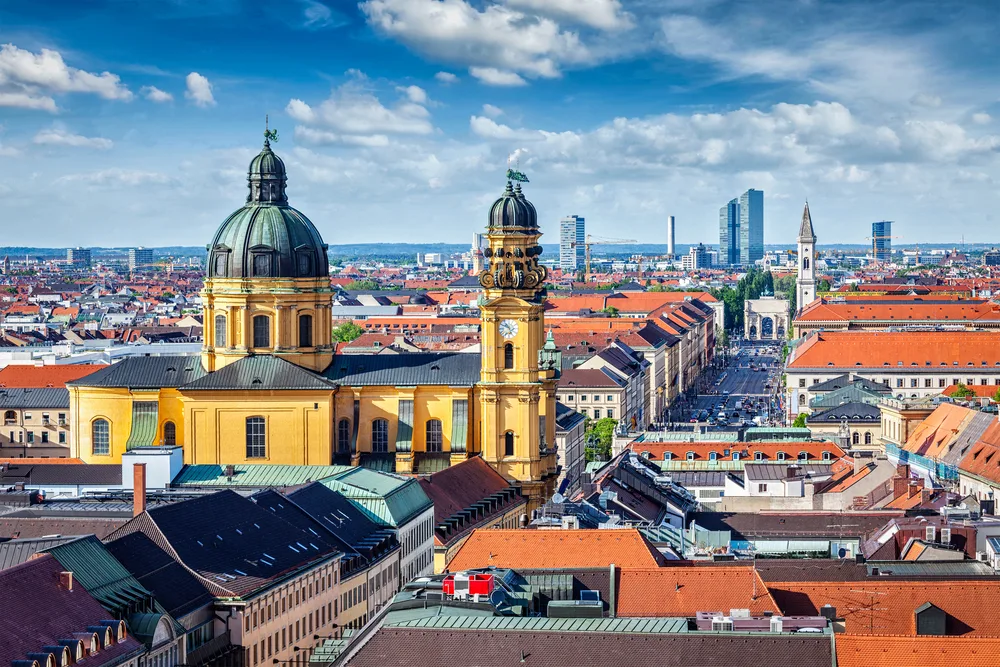
Dmitry Rukhlenko/Shutterstock
The capital of the southeastern state of Bavaria, Munich, has a village vibe and never takes itself too seriously. This is the home of the original Oktoberfest, with its traditions of beer, polka music, sausages and pretzels, and colorful lederhosen and dirndl.
The celebration continues year-round at Munich’s vibrant biergartens, where you can stop in for camaraderie, a pint, and some greasy, delicious food. But the city’s Old Town (Altstadt) offers a bit more in the way of history and culture. Frauenkirche, a 15th-century Gothic cathedral here that dominates the skyline, is the city’s most recognizable feature.
Marienplatz Square is where you’ll find the historic Gothic Revival town hall, Neues Rathaus, where the largest glockenspiel in Europe is housed in the tower and plays with dancing figures at 11AM and 12PM daily. Stroll shopping streets like Kaufingerstrasse and Theatinerstrasse and visit Alter Peter church for amazing views.
This is a city where “breakfast beers” with weisswurst (white) sausages are a thing, so start your day at Schneider Weisse brewer on Tor Street near Marienplatz. Head out on a bike or walking tour to see Max Joseph Platz, WWII history at Odeonsplatz, Hofgarten, and the famous English Garden where the Chinese Tower biergarten is housed.
Grab drinks and bar bites afterward at Hofbrau or Sausalitos, then wait for a second wind to hit Munich’s bar and club scene later that night. Get lost in the array of bars and dance clubs at Kultfabrik, which also boasts a casino, concerts, skate park, and more.
Automobile lovers will have to check out the amazing engineering of German cars at the BMW Museum, and don’t miss the Baroque Nymphenburg Palace with its maze of gardens and endless, period-decorated rooms.
3. Dresden
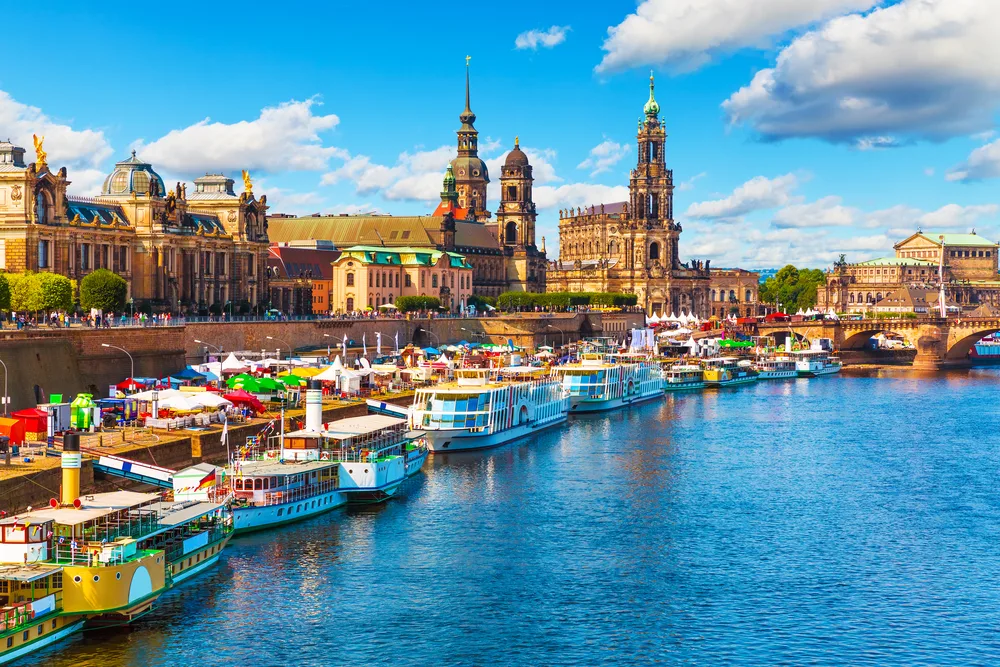
Oleksiy Mark/Shutterstock
Dresden is another great place to visit in Germany, offering stunning Baroque architecture and palaces, riverfront views, historic cable cars that take you up the mountain to posh mountain villages, and excellent museums showcasing centuries of history.
The Dresden royal palace, or Residenzschloss, is stunning with its ornate and intricate Baroque style and detail in the heart of the city near other Baroque highlights, like the Zwinger palace complex (head to the rooftop for great views), the Semperoper opera house, and the Frauenkirche church.
Plan a visit to the Green Vault, or Grünes Gewölbe, Dresden’s historic treasury-turned-museum, and don’t miss the chance to see the famous Fürstenzug mural. You’ll appreciate the views from the Blaues Wunder (Blue Wonder) Bridge over the river Elbe.
When you’re feeling peckish, Dresden’s culinary scene is phenomenal and rich in pastries, desserts, and savory German dishes centering around sausages, roasted meats, potatoes, bread, and cheese.
You’ll find endless options along Prager Straße, the Main Street. Try Sauerbraten mit Rotkraut, roast beef with sweet and sour gravy, and grab the triple-layered eierschecke for dessert.
4. Hamburg
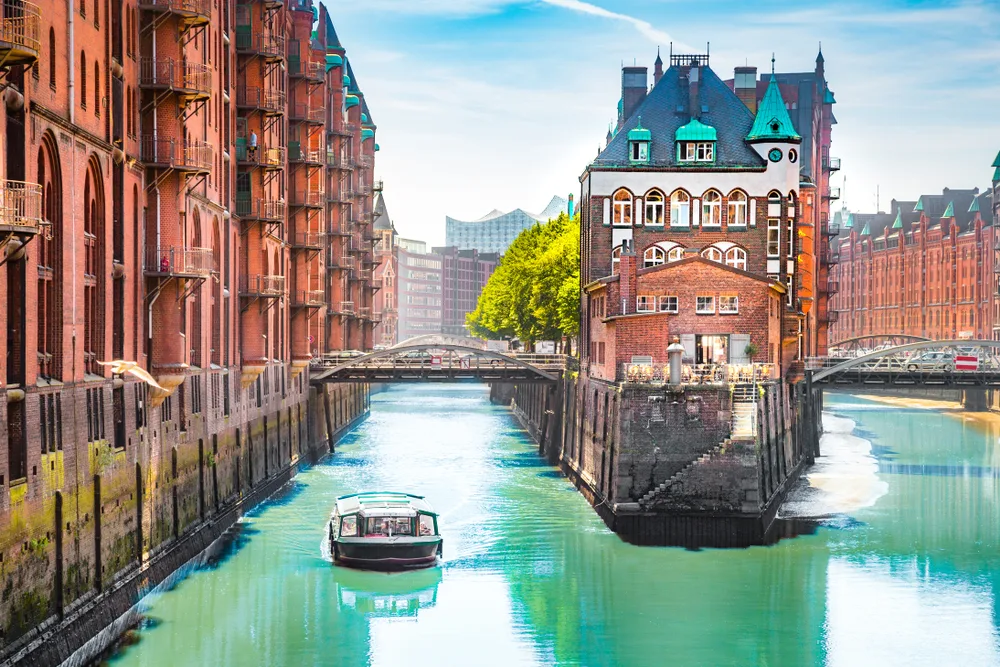
Canadastock/Shutterstock
As Germany’s second-largest city, the port city of Hamburg has a long-spanning history rooted in its location on the Elbe River and the network of canals and lakes that intersect the city. Its Old Town (Altstadt) and New Town (Neustadt) give you a taste of both past and present in this maritime city.
Hamburg is largely a green city that feels like a massive park. You’ll find picturesque areas throughout its bounds, from Inner Alster Lake with lovely waterfront cafes to Planten un Blomen with its vast botanic gardens in the heart of the city. Rent a boat to explore the canals or walk through the Elbtunnel under the river!
Cultural and historic sightseeing is endless here, with places like the Altonaer Museum, the Auswanderermuseum Emigrant Museum, and the International Maritime Museum that details the city’s long waterfront history. See the stunning 18th-century Baroque St. Michael’s Church with its tall clock tower.
The charming tree-lined Mönckebergstraße in the Old Town is fun to stroll, passing small shops to department stores on the way to historic Renaissance-Revival style City Hall and the Rathausmarkt square, where you’ll find events and festivals set up throughout the year.
Head to Lange Reihe in St. Georg or Schanzenviertel to find an array of great restaurants in Hamburg. Eat a local fried fish sandwich, or Fischbrötchen, and it’s your chance to try Franzbrötchen, a cinnamon sweet roll only found here.
Two nightlife districts, Schanzenviertel (bars, lounges, restaurants) and Reeperbahn with its Hans-Albers-Platz square (clubs, partying, and red-light district), give you plenty of options to let loose when the sun sets. Fans of the unique will appreciate the massive model train village and all things miniature (carnivals, airports, etc.) at Miniatur Wunderland!
5. Heidelberg
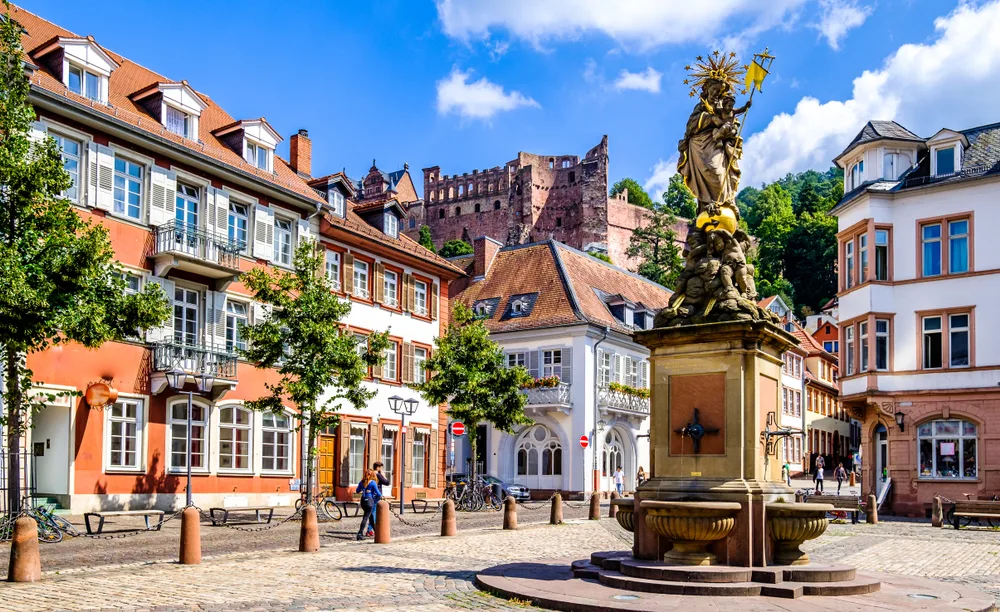
FooTToo/Shutterstock
Sitting on the Neckar River in Germany’s southwestern region, Heidelberg is one of the best places to visit in the country with cobblestone streets and alleys, a bustling market square, Renaissance castle ruins, and historic architecture in its charming Old Town.
Just over an hour from Frankfurt, Heidelberg is often passed over by tourists, but that’s part of what makes it special. Uncrowded and slower-paced, you’ll be able to wander the streets, eat delicious German food, and check out great markets, museums, and sightseeing tours.
The 14th-century Heidelberg University campus is here, along with the impressive ruins of the hilltop Renaissance Schloss Heidelberg castle, which was partially rebuilt after being demolished in the 17th century.
Handschuhsheim, a castle from the Middle Ages with a moat and drawbridge, is well worth checking out on your walk. There’s a beautiful Gothic church, Heiliggeistkirche, in front of the Marktplatz in the Old Town. The Studentenkarzer, an old student prison, and Kurpfälzisches Museum make other cool sightseeing opportunities around the village.
Up on Heiligenberg, the forested hill overlooking the city, ancient to medieval history abounds. Celtic fortifications, pre-historic structures, and medieval monasteries and lookout towers are on the hill. You’ll also find the Nazi-built Thingstätte amphitheater here.
When it comes to dining, a stroll down Altstadt Hauptstraße will present you with endless opportunities to eat, drink, and shop at local boutiques. It’s one of the best areas of Heidelberg and a great spot to spend an afternoon!
You’ve got to stop by Hotel & Restaurant Schnookeloch for ham hock haxen or the pan-fried “Schnitzel Wiener Art” pork tenderloin with homemade potato salad.
6. Leipzig
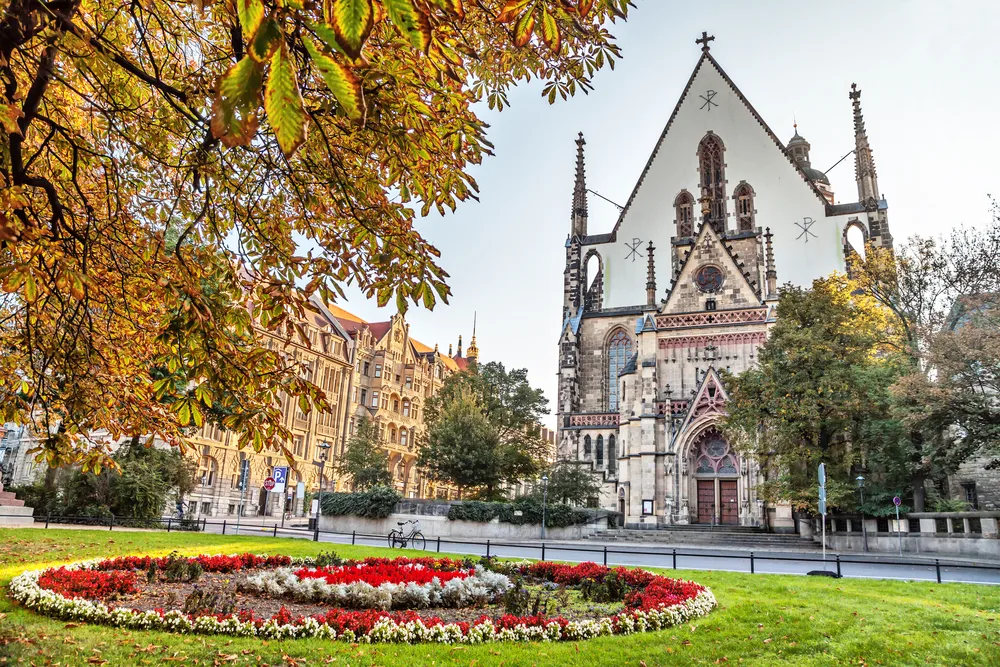
Sergey Dzyuba/Shutterstock
Leipzig appears to be a fairytale brought to life with its detailed Baroque and Wilhelminian style architecture, stately monuments and towers, and classical music roots. Bach is buried here and the area is lush and green with excellent parks and waterways in town.
Walk or bike down the riverside in the center of town to the vast English-style Clara Zetkin Park. If you continue south, you’ll end up at the Cospudener See lake with beautiful views and a sandy beach area. It’s a great launch point for kayaking, or head west to Plagwitz if you’d like to tour the canals in a boat.
St. Thomas Church, or Thomaskirche, is where Johann Sebastian Bach (he was the church’s former music director!) is buried and can be visited on the ring road in the heart of the city. St. Nicholas Church is considered the city’s most beautiful with elements of Baroque, Romanesque, and Gothic styles.
You’ll see the massive Monument to the Battle of the Nations near Napolean’s command post and City-Hochhaus (a skyscraper that towers above the rest of the city) with the Panorama Restaurant at the top offering stunning views over the city.
Auerbachs Keller is another place to grab a bite and glass of wine, and it’s the second-oldest restaurant here that dates back to the 1400s below the covered Mädlerpassage in the historic district.
Germany’s reunification can be studied and explored in depth here with the free Zeitgeschichtliches Forum museum and English audio guides. The Museum für Bildenden Künste (Museum of Fine Arts) features some of the best pieces by German artists, including Caspar David Friedrich and Max Liebermann.
7. Regensburg
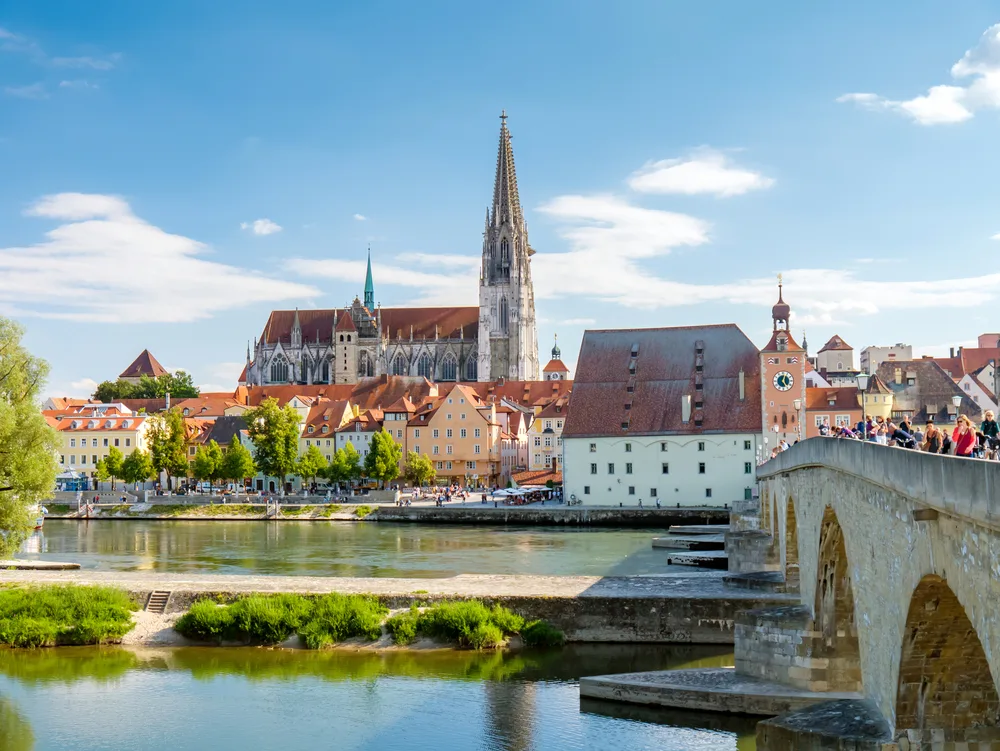
mitchFOTO/Shutterstock
On the Danube River in Bavaria, the medieval architecture and quaint cafes, shops, and markets of Regensburg make it one of the best places to visit in Germany. It has cobblestone streets, Gothic cathedrals, interesting museums, and a charming downtown district.
Your tour should begin at the Gothic Cathedral of St. Peter, where you’ll see Renaissance-era graves and large frescoes. Stop by the Museum der Bayerischen Geschichte, or Museum of Bavarian History, to learn about the wider southeastern German state.
There’s also St. Jakob’s Church, where Neupfarrkirche’s remains are kept, and neat destinations with a long history like Haidplatz Square and the Dachau Gate. Both date back to the 16th century!
An old bridge over the Danube with rows of arches from the 12th century, Stone Bridge, is how you’ll cross over into Regensburg’s medieval Old Town and discover the 13th-century Regensburg Cathedral, a market, and city hall building built between the 11th and 13th centuries.
As a UNESCO World Heritage site, the old downtown area features charming cobblestone streets, small cafes, local boutiques and bars, and lots of places to pop in during your stroll. River tours on small boats give you a cool perspective of the city.
Check out the medieval restaurant, Geflickte Trommel, to try mead in different varieties and specialities like roast suckling pig and unique Flammkuchen (French-German) pizzas.
Or head to Irish Harp near the Stone Bridge for pub fare and live music! Biergartens on Stadtamhof in the center of the river is another cool place to eat and drink with great waterfront views.
8. The Black Forest
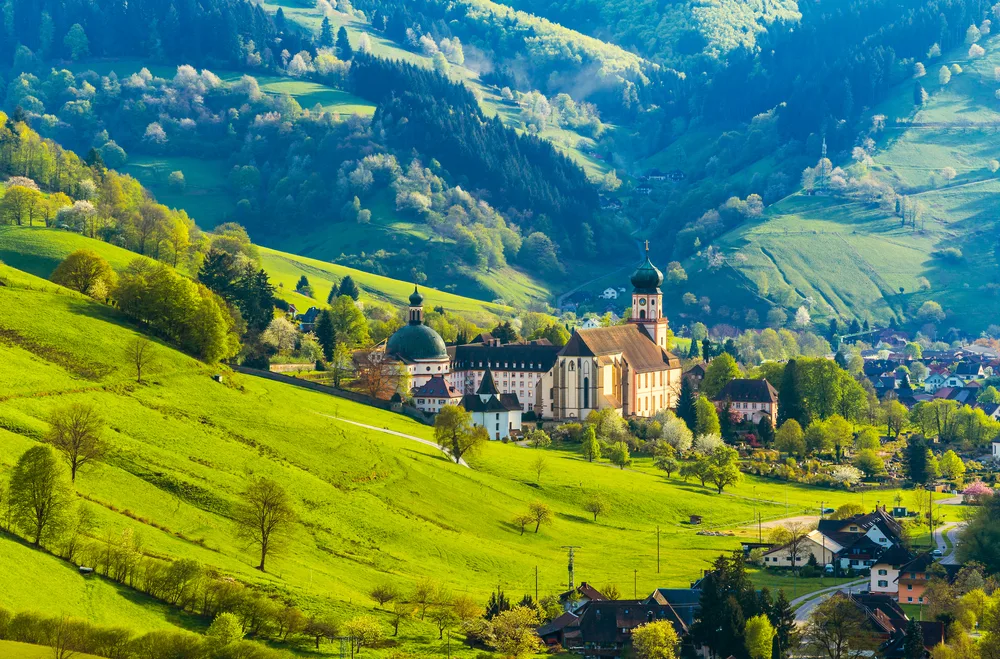
Funny Solution Studio/Shutterstock
A true storybook setting in the wilderness of Germany, the mountainous Black Forest is nestled in the country’s southwestern region and features evergreen forests, charming little mountain villages, and amazing opportunities to enjoy the great outdoors in all seasons.
People come to the Black Forest for a number of reasons. Some want to see the place that inspired the Brothers Grimm fairytales like Hansel and Gretel, Sleeping Beauty, and Rapunzel. Some want to ski, hike, and see waterfalls and mountain views.
Others want to explore the tiny villages, try traditional Bavarian food and drink, and see the region’s famous cuckoo clocks as they stroll the picturesque streets.
Freiburg, the largest village in the Black Forest, is where you’ll find stunning Gothic architecture among its cathedrals, minsters, and preserved 12th-century medieval city gate, Martinstor, in its Old Town.
You’ll find plenty of places to enjoy a good hike, with Black Forest National Park offering some of the best in the region (including short loops and long, challenging hikes). Fall and winter here is magnificent as the leaves change color and the landscape gets blanketed in soft, white snow.
The towns in the region are all connected by train for easy access, and you’ll want to see Karlsruhe and its castle, Baden Baden for its luxe spas, Bad Wildbad for a cable car up the mountain for outdoor recreation, and Gengenbach for its classic village vibes with cobblestone streets and Old World Bavarian architecture.
9. Cologne
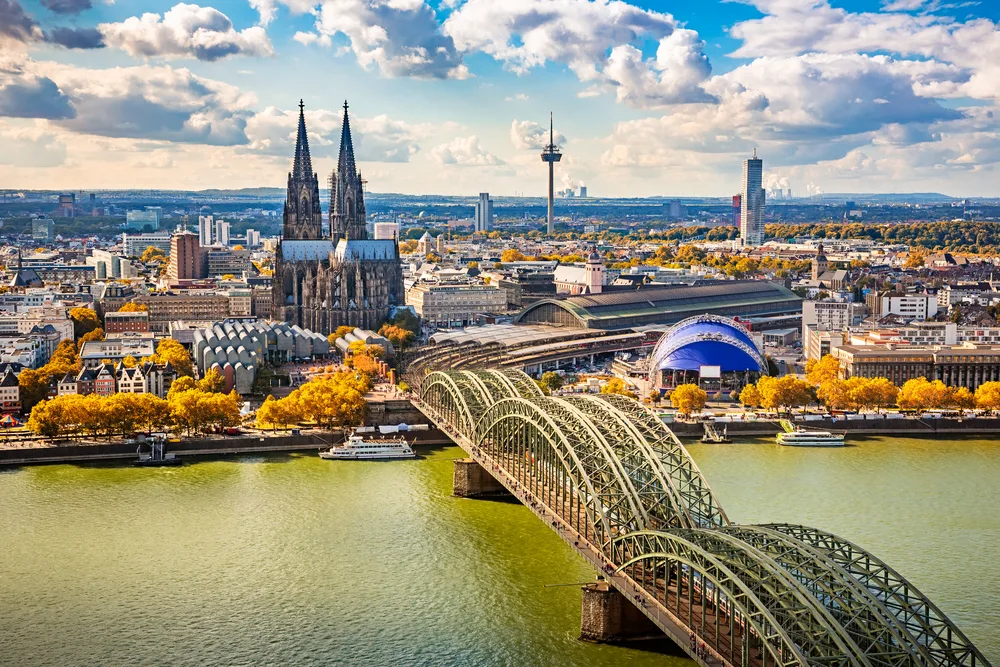
S.Borisov/Shutterstock
Riverfront Cologne makes an excellent place to visit in Germany, owing to its prime location on the Rhine River and majestic skyline with twin Gothic spires and towers rising above the vibrant city. It’s full of great restaurants, pubs, and shops and is a very inviting city to visit.
Looking at Cologne’s skyline, you’ll notice the Gothic Kölner Dom, or Cologne Cathedral, right away with its towering twin spires. It’s the second tallest twin-spired cathedral in Europe. You can tour the cathedral and climb the stairs up to the top!
The center of the city is the Old Town and it’s the perfect place to spend your morning and afternoon exploring. It dates back to Roman times and you’ll see elements from the Middle Ages all the way to World War II in this area!
While you’re here, try the local beer, Kölsch, available around the city at local restaurants and breweries. The food in Cologne is great and slightly different, with meals like Rheinischer Sauerbraten, or marinated pot roast, and Himmel un Äd, which is black pudding with potatoes and applesauce.
Nightclubs and rooftop bars are a big deal in Cologne, so check out local favorites like Bootshaus and Club Bahnhof Ehrenfeld if you’re up for a late night with drinks, music, and dancing while you’re here.
10. The Rhine Valley
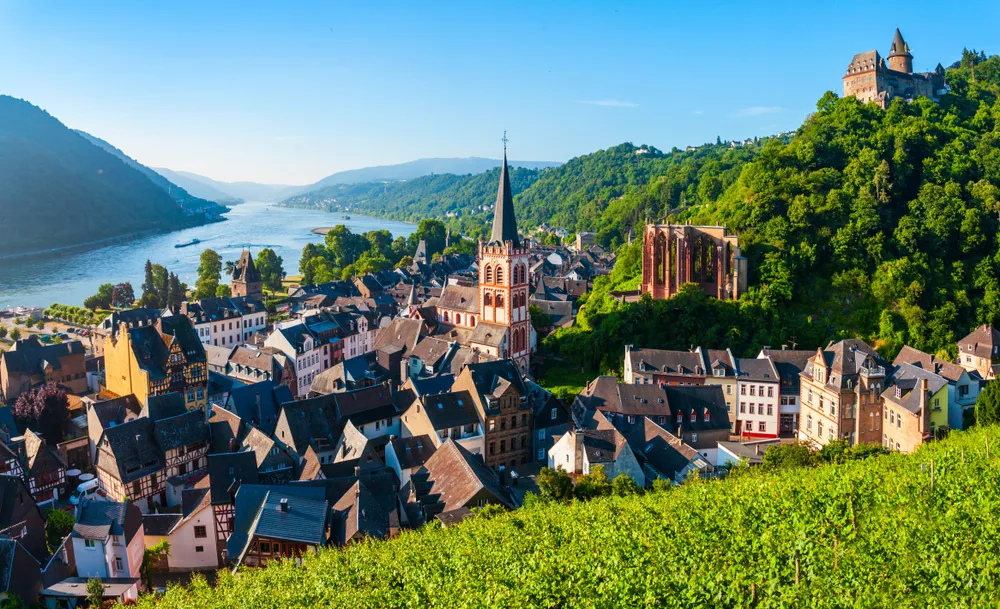
Saiko3p/Shutterstock
Germany’s Rhine Valley is one of our favorite places to visit in the country with gorgeous riverfront and mountain views. You’ll find pleasant little villages to larger cities bustling with markets and restaurants to check out throughout the valley.
The Rhine Valley is home to a range of German villages, towns, and cities that have preserved their history and architecture well, some from the medieval era and earlier. This is an ideal spot to admire both natural and manmade beauty!
The Middle Rhine is one of the best areas to visit if you’re looking for sightseeing opportunities and chances to explore outside. You’ll find castles, medieval forts, and vineyards. There’s also Lorelei, a tall cliff that legend says is topped by a slate siren that lures sailors and fishermen to their deaths in the Rhine.
Special cities to check out while you’re in the valley include Düsseldorf, Cologne (listed above as one of the best places to visit in Germany), Rotterdam, Basel, Duisburg, Strasbourg, and Arnhem.
You’ll find amazing opportunities to enjoy the natural beauty of the valley with ample hiking and biking trails, walking paths, skiing and winter sports, water sports, canyoning, rock climbing, and more.
11. Island of Rügen
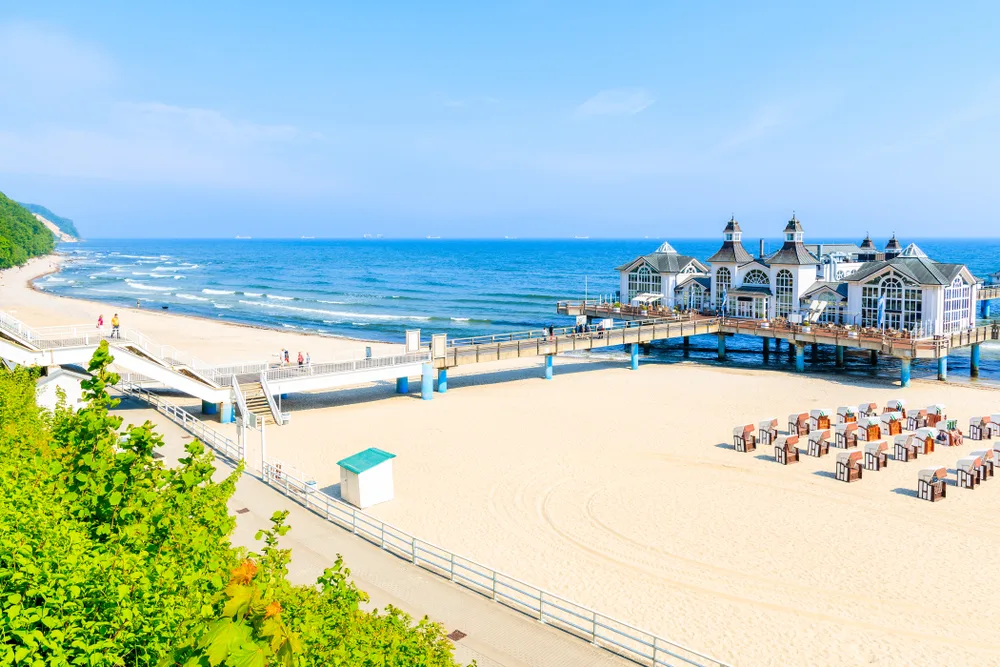
Pawel Kazmierczak/Shutterstock
You don’t think of islands when you consider Germany, but the island of Rügen is one of the best spots to visit! Beaches, waterfront cafes and restaurants, unique shops, and a high-end vibe with surrounding forests and islands make it truly special to visit.
Sitting just off the northern coast of Mecklenburg-Vorpommern, Rügen is a hotspot for tourists when the weather is warm and has endless ways to get out and enjoy the sunshine and water.
Its beaches, like Binz Beach and Sellin Beach, boast powdery white sand that contrasts nicely with the lush, green forests and brilliant blue water. Head to one of the beachfront cafes to fuel up and grab a drink, like Gastmahl des Meeres (it’s also a hotel).
Jasmund National Park is on the island, offering wilderness trails through stands of beech trees that lead to the sea and afford you chances to spot eagles, cool white chalk cliffs, and step out onto the observation deck over the water.
Water sports are a favorite pastime on Rügen, so rent a kayak, paddle board, or windsurfing gear to enjoy the island’s adventurous side when you’ve explored its forests and want to see the Baltic Sea stretch out before you.
The Granitz Hunting Castle is a spectacular sight and features a spiral cast iron staircase that leads up to the central tower and its very own beer garden on the lower floor inside. Lighthouses along the shore also make cool stops on your trip, and you can climb up for incredible views.
12. Lake Königssee
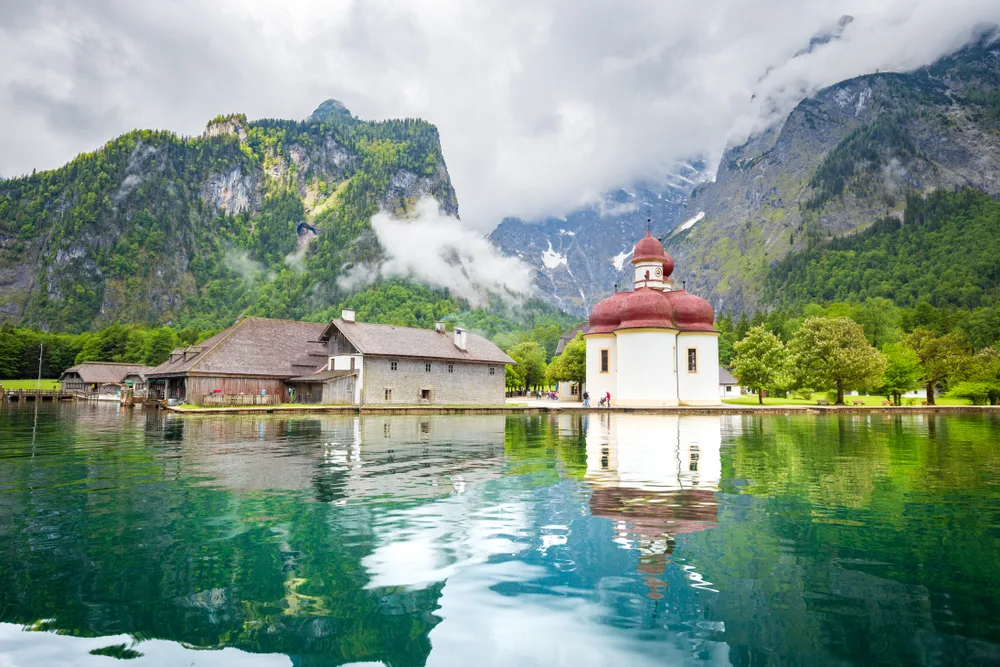
Canadastock/Shutterstock
Shining like an emerald in Bavaria near the border with Austria, Lake Königssee’s sparkling green waters are surrounded by the Bavarian Alps in the beautiful alpine Berchtesgaden National Park. It’s a favorite place for both locals and tourists to visit in Germany.
Chalk particles dissolved in the water give it the characteristic verdant color that ties it in so well with the dense evergreen forests on the mountains that wrap around it. You’ll feel like you’re tucked into a secret paradise while you’re on the water!
It’s a hotbed for water sports in the warm months of the year, with paddle boarding, kayaking, boating, sailing, fishing, and lake cruises that add so much enjoyment to a lake day on Königssee. The water is chilly, even in the summer (around 68°F), so swimming might be uncomfortable.
The little village where the boat docks are sits on the northern end of the lake (Schönau am Königssee) and makes a great launch point for water adventures. There’s the hidden St. Bartholomew church on the western shore, only reachable by boat or hiking, and Salet, the final stop on boat cruises where you can disembark and take a stroll over to the nearby Obersee Lake.
Ride the Jenner funicular up the mountain to the observation deck for incredible views over both lakes and keep going up to say you’ve climbed part of Watzmann, the majestic mountain overlooking Königssee.
13. Nuremberg
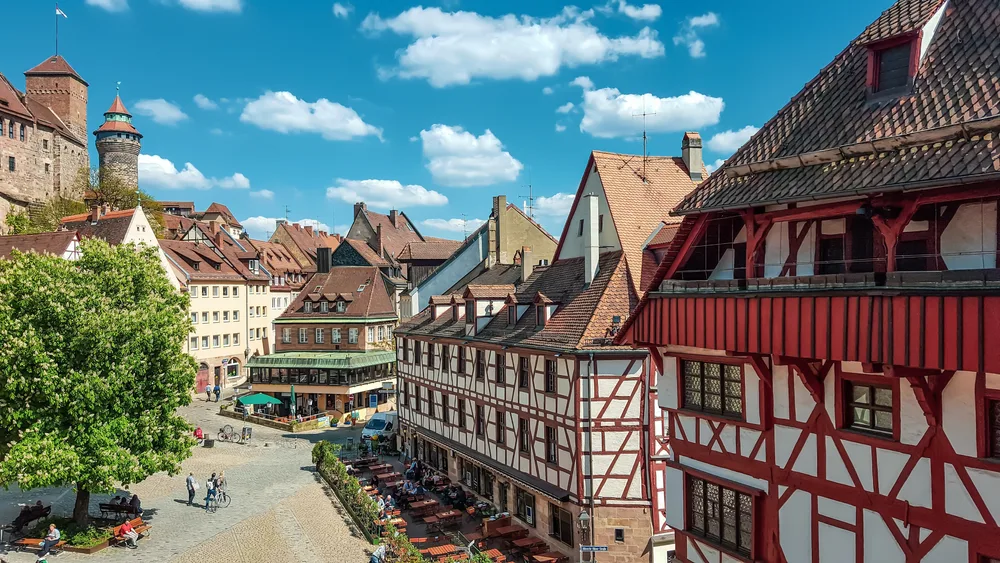
Ele Sviridova/Shutterstock
Stick around in Bavaria and head about 4 hours northwest to reach Nuremberg, a city of chalets and Bavarian architecture, tree-lined cobblestone streets, and riverfront restaurants that face the green Jura Mountains.
It’s a very charming city, and its location on the Pegnitz River makes its vibe and cuisine a little different from other parts of Germany. Fresh-shucked oysters, salmon, trout, and carp are the norm along with German classics like smoked sausages and the local specialty, lebkuchen (gingerbread).
But the sights within the walls of the Old Town might be your favorite part of visiting Nuremberg. There’s the medieval-era Imperial Castle of Nuremberg in the center of town with its fairytale watchtower and arched doorways and scenic old bridges like Henkersteg Bridge.
The southern end of the Old Town, Lorenzer Altstadt, is where you’ll find the medieval St. Lawrence Church with its imposing twin spires, but Sebalder Altstadt (the northern end of the Old Town) is the most picturesque. The streets are narrow and wind past traditional Bavarian houses and shops.
There, you’ll find the Main Square with more modern buildings and lots of great places to eat, drink, and shop. Be sure to check out the 14th-century Church of Our Lady and the gold-accented Schöner Brunnen fountain!
If you happen to be here in December, the city really sparkles with life and light at Christmas time. This is when Christmas-themed markets fill the streets with crafts, snacks, warm beverages, and holiday decor galore.
14. Meersburg
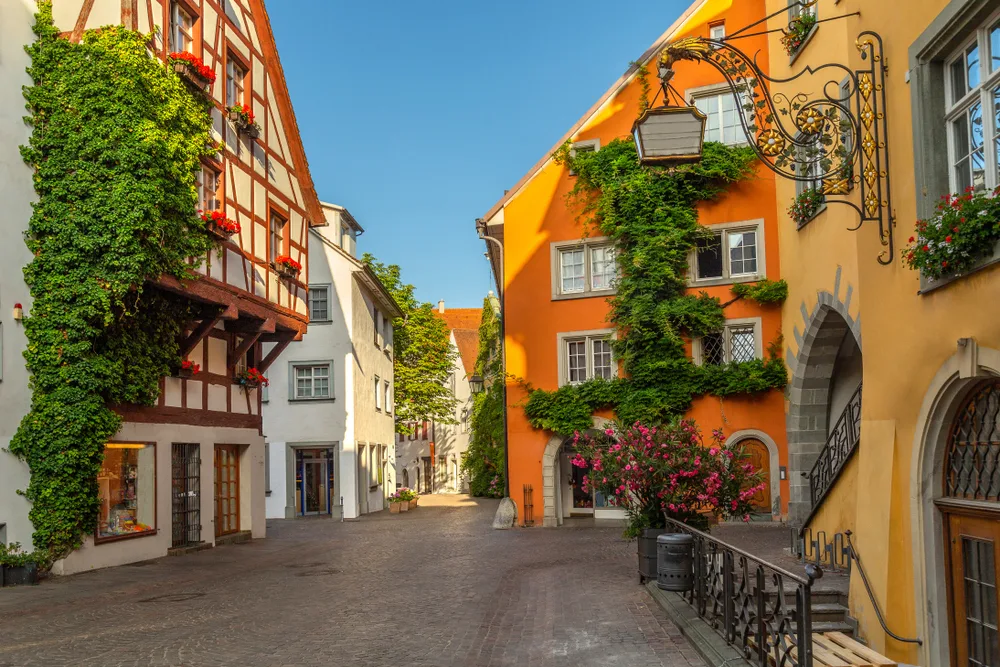
Hunry_herbivore/Shutterstock
Sitting on the northeastern shore of Lake Constance (Bodensee) in southern Germany, Meersburg is a quaint medieval-era town that offers incredible waterfront and mountain views, great museums, palaces and castles, and charming cobbled streets.
You’ll want to check out the Zeppelin Museum if you’re an aviation or history buff, and Burg Meersburg castle and Fortress Museum. The castle is nearly 1,500 years old on a scenic hill overlooking the lake and the museum features a castle dungeon!
The New Palace is done in ornate Baroque style with larger-than-life frescoes making it well worth a stop when you’re here. The German Clock Museum and Droste Museum are great stops if you’re into history and learning about German culture.
As a lakefront town, tourism is big in this village and things really pick up when the weather is warm. Water sports are widely available with equipment rentals, boat tours, and people enjoying the sunshine on the lake.
Take the ferry over to Konstanz for a day trip, another lakefront town with great medieval architecture in its Niederburg Old Town district, like the Romanesque Konstanz Cathedral. Unteruhldingen is close by, and its Pfahlbauten open-air museum features Bronze-age “sunken city” dwellings.
15. Wetterstein Mountains
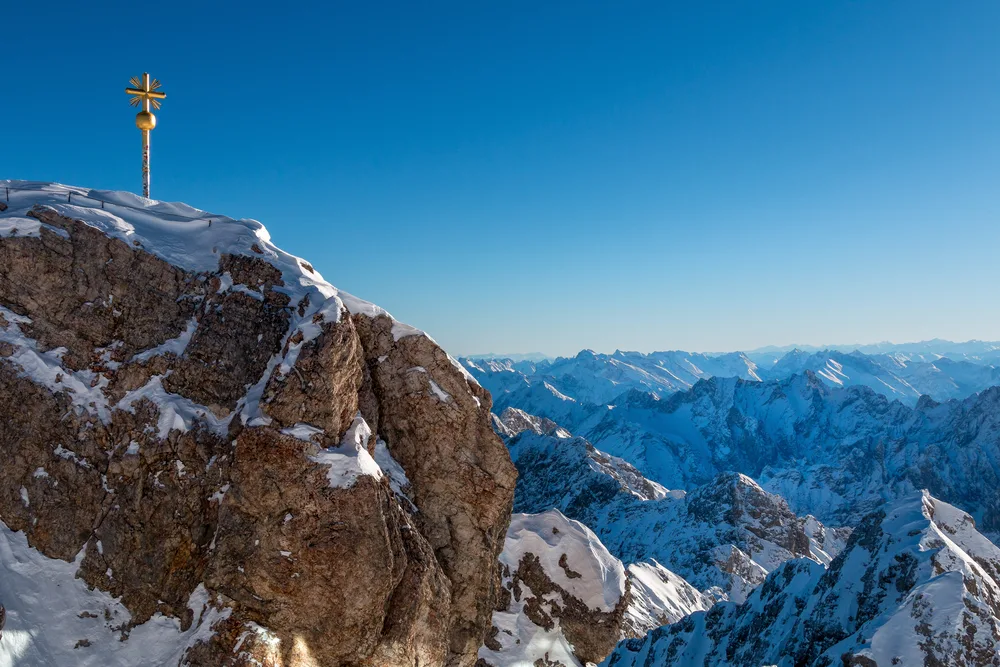
Kurt-Georg Rabe/Shutterstock
The rugged Wetterstein Mountains near Germany’s border with Austria make an incredible place to cap off your visit to Germany. This range is home to Germany’s tallest peak, Zugspitze, that stands over 9,700 feet (2,962 meters) above sea level in Bavaria.
Spending time in this mountain range will reward you with some of the most awe-inspiring views over Germany and Austria, seeing blankets of evergreen forests, alpine lakes, sprawling cities, and tiny villages down below. Zugspitze is close to Garmisch-Partenkirchen in Bavaria.
If you decide to make the trek up Zugspitze — or heck, just take the Zugsptize cable car up the mountain — you’ll be able to look down into five undulating valleys dressed in green or white snow, depending on the season. Germany, Austria, Italy, and Switzerland can be seen from the summit.
The Wetterstein Mountains also hold captivating castles that are thrilling to see and tour on the mountain’s edge, looking out over these panoramic views. Neuschwanstein Castle is a must-see and the inspiration for Walt Disney’s Cinderella Castle!
Nearby ruins of Werdenfels Castle sit in the Loisach Valley, while the scenic Lake Wagenbrüchsee is enveloped in the mountains with peaceful meadows and forests around it for a relaxing day trip.
Things to Consider
Whether you’re planning to hit one or several of the best places to visit in Germany, you’ll have a more enjoyable stay when you keep the following travel tips and suggestions in mind.
- Learn some German. Even though English is widely known and spoken in the majority of large cities, learning a few German words and phrases will take you far when you visit. You’ll interact with locals more effectively, have an easier time reading signs and menus, and make some new friends!
- Exchange your currency. Germans use the euro for currency, so you’ll want to exchange your dollars (or whatever currency you have) at the airport, a currency exchange counter, or use an ATM in one of the bigger cities. Be aware that international ATM fees can be high and exchanging is the better option!
- Germans don’t drive on the left. Most European countries drive on the left, but Germany, like the U.S., drives on the right. That makes getting around in a rental car so much easier if you’ve been sweating learning how to drive on the “wrong” side of the road!
- Don’t forget to tip. Some countries don’t do tipping, but Germany participates in this custom and tips are always appreciated for good service you receive. People serving or helping you at restaurants, bars, hotels, salons and barbers, and special excursions should be tipped a small amount, usually a few euros.
Frequently Asked Questions
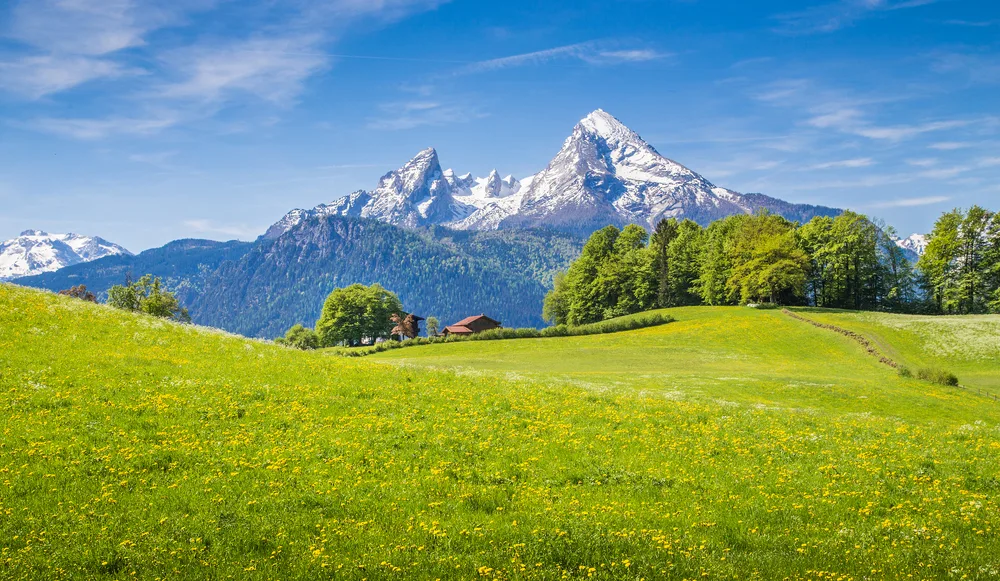
Canadastock/Shutterstock
Visiting Germany to see its most incredible destinations seems like a tall order, but with a list of the best places, you’re one step closer to making your dreams come true! Take a look at the FAQs below to learn more before you start planning.
What is the most beautiful region of Germany?
Most people agree that Bavaria is Germany’s most beautiful region. This area offers impressive Bavarian Alps, charming cobblestone streets and half-timbered houses, panoramic views with alpine lakes and lush green valleys, and delicious regional dishes and sweets.
There are numerous breathtaking places to discover, from Munich and Nureumberg to the famous Neuschwanstein Castle and Zugspitze, Germany’s highest mountain peak.
What is the #1 tourist attraction in Germany?
The entire Bavaria state in Germany is the most-visited attraction in the country, seeing tourists spending 94.3 million nights in the hotels and hostels around this scenic, alpine destination.
Old World half-timbered architecture, cobbled stone streets, quaint little cafes and riverfront pubs, and unique shops populate the Bavarian towns. Skiing and snow sports are popular in the Bavarian Alps during the colder months, with hiking and lake sports taking over in spring and summer.
Which part of Germany should I visit first?
Berlin is the ideal starting point for anyone interested in exploring Germany. This vibrant city is loaded with museums, nightlife, trendy restaurants, and historic landmarks.
If you're looking for a more rustic experience, go to Bavaria in the south. You'll find charming storybook villages tucked away among sweeping hills and rugged mountains with a slower-paced feel.
Which part of Germany is considered to be the most beautiful?
The Black Forest is widely considered one of Germany's most beautiful regions, thanks to the dense evergreen forests that line the rugged mountain peaks and overlook clear-water lakes. Brothers Grimm fairytales were inspired by this enchanting region.
Munich is frequently rated as Germany’s most attractive city. Its old-world elegance and dynamic modern metropolis make it genuinely exceptional. Munich has something for everyone with its spectacular architecture, top-notch museums, vibrant beer gardens, and lovely parks.
Is Austria or Germany prettier?
It's impossible to objectively compare whether Austria is prettier than Germany because beauty is in the eye of the beholder. If you appreciate alpine scenery and charming villages with old-fashioned architecture, you'll like Germany's Bavaria as well as the Austrian state of Tyrol.
For bigger cities with lots of culture and nightlife, both Germany and Austria offer pretty options like scenic Berlin with waterways and forests and the sprawling, forested capital of Vienna with great architecture.
So, What Is the Best Place to Visit in Germany?
The best places to visit in Germany are scattered throughout the entire country — from the modern counter culture capital, Berlin, to the rugged peaks of the Wetterstein Mountains on the border with Austria.
This is a land where you can wander through alpine villages and their cobblestone streets, marvel at medieval churches and hilltop castles, plan for days of outdoor recreation and fun, and fill your belly with hearty, German dishes and street eats that are sure to satisfy.
History, scenery, nightlife, great food and drinks, and culture are just a flight away in Germany. Put the best places to visit on your itinerary and prepare to enjoy your upcoming trip with memories that last a lifetime!



